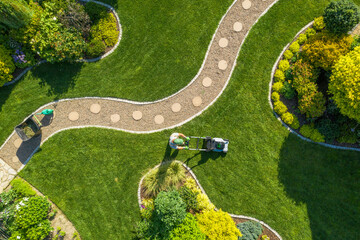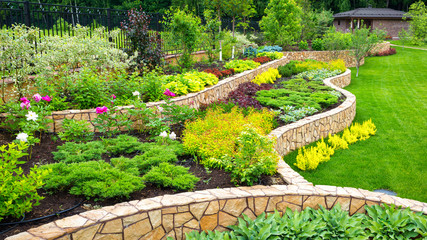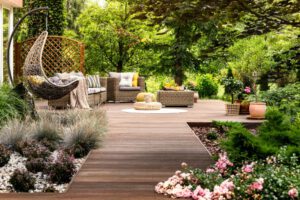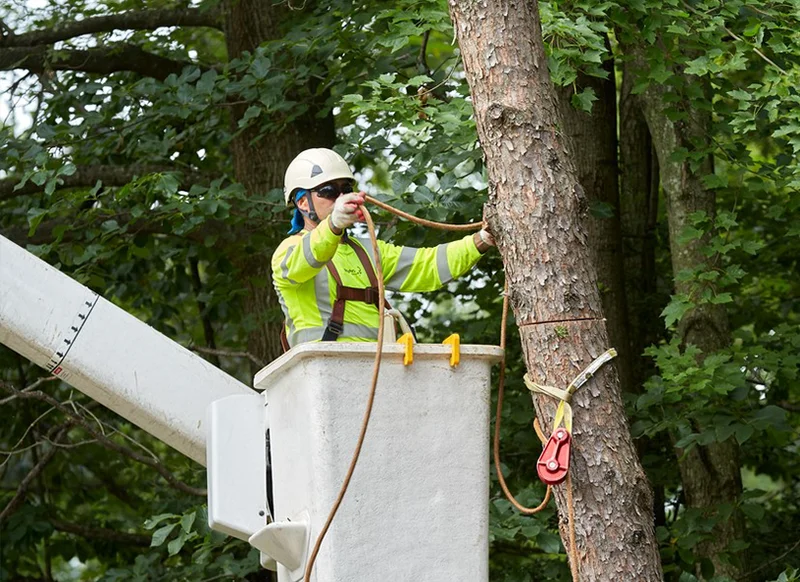Landscaping Design involves manipulating basic design elements to create a pleasing aesthetic. Learn about these design principles and how to use them in your landscape. Visit Landscaping Harrisburg PA for more details.

Proportion refers to the relationship of size between different objects and features in a garden or landscape. It can be symmetrical or asymmetrical.
Color is one of the most important elements in any landscape design. It can enhance features like water and paths and draw attention to plants and flowers. There are many colors, so it’s important to consider how they will work together in your landscape.
Color can create a sense of hierarchy, or order. Using different size plant elements, contrast of color, and the use of texture can help a design feel organized and balanced. The use of color is also a great way to create transitions between different parts of your yard. For example, using a different color for the flowers that you place near a path or patio can create a smooth transition from one part of your yard to the next.
A common color scheme is called monochromatism. This involves using tints and shades of a single color to create a cohesive look. For example, if you love the color purple, you can create an elegant garden design with various hues of this shade.
Another popular color scheme is complementary, which uses colors that are opposite each other on the color wheel. This type of palette is bold and dramatic and can be effective when used in the right setting. However, it is important to note that this is the most difficult color scheme to implement successfully because it can easily become chaotic and disorganized.
A well designed landscape should incorporate a variety of forms. This includes the shape of plants as well as hardscape features like outdoor fireplaces and retaining walls. Having a variety of forms prevents a landscape from looking monotonous or dull.
Form also helps give a landscape a certain style or theme. For example, if you are going for a formal garden, you might want to use straight lines and more structured, trimmed plants. While if you are trying to create a natural look, you might opt for curved lines and more organic, flowing plants.
Another principle of form is proportion, which refers to the size relationship between different elements in a landscape design. For example, if you have a large tree or bush against a house, you might want to add smaller plants around it to balance the scale of the landscape.
Line is another important element of a landscape design, and it can be either horizontal or vertical. It can also be asymmetrical or symmetrical. Landscape designers use lines to guide the viewer’s eye throughout the landscape and to establish a rhythm, accents, and unity.
The final principle is balance, which refers to a sense of equilibrium in the three-dimensional arrangement of landscape elements. Landscapes can be balanced symmetrically or asymmetrically, using a variety of plants and structures that have equal visual weight.
One of the most important landscape design principles is line, which influences the way we perceive space. It can be a line of paving or structure, the boundary between two different surface materials, as in grass and stepping stones, the outline of a plant or the shape of a structure, like a gazebo or gateway. It can also be a directional sight line, which may lead the eye into or out of a landscape.
To create a sense of rhythm in a landscape, repetition is often used. Repetition can be symmetrical or asymmetrical and can involve the use of similar forms, colors or textures. The repetition can be gradual or abrupt, depending on the desired effect.
The golden ratio, or the division of a line into equal parts, is another key landscaping design principle that is found throughout nature – in flower petals, hurricanes, animal bodies, the proportions of human faces and DNA molecules. Although a bit technical (and there’s math involved), understanding this proportion is very helpful in creating a harmonious, balanced outdoor space.
Unity, or harmony, is a landscape design concept that is achieved through dominance and interconnection, the Rule of Three, and simplicity in arranging textures, forms and colors. It results in a cohesive, beautiful garden that flows together smoothly.
Flowing movement in landscaping design is achieved through a balanced use of contrast and harmony. Contrast makes certain elements stand out and draws attention, while harmony creates cadence and unity. This is achieved through the use of concepts such as dominance, interconnection, the rule of three and simplicity in arranging textures, forms and colors.
Landscapers must consider the size of plants and hardscape features, as well as their placement, to create flow. They must also keep in mind the function of the space and how it will be used. For example, a swimming pool may be excessive for a small garden, while a large fountain could overwhelm a small lawn.
Forms come in a variety of shapes including square, rectangular, elliptical and natural but one project should stick with a few forms to avoid creating a visual overload. Forms also play a key role in determining the overall style of the landscape, whether it be formal or informal, contemporary or traditional.
Color is another crucial element of landscaping. It can add a pop of color or offer a more subtle tone depending on the season. Landscapers often use contrasting hues to create depth, such as warm colors like reds and oranges to make objects appear closer and cool colors such as greens to create distance. They also pay close attention to how the color of a plant or hardscape surface complements its surrounding elements.
The way that a landscape design is sequenced plays an important role in how visitors experience it. Whether it’s a small rose garden, large water feature or hardscape area, the arrangement should be unified and have a focal point. To help achieve this, the design elements of dominance, interconnection, unity of three and simplicity in arranging textures, forms, colors and forms should be used to guide the eye around the space.
The scale of landscape features is also important as the size can either overwhelm or entice the viewer. Using the Golden Ratio (1.618) as a guideline can make a landscape feel balanced and harmonious.
Sequence involves creating smooth transitions in the size, shape and texture of plants. Abrupt changes from tall to short plants or from fine to rough textured plants can look harsh and are best avoided. Repetition and rhythm also add to a seamless design.
Simplicity is an important principle of landscape design as too much variety distracts and dilutes the overall look. It is important to limit the number of colors, forms, textures and construction materials to create a cohesive design. However, simplicity can be taken too far and result in a dull landscape. A great way to maintain balance is through the use of a theme or style for the entire space. Examples of themes include Formal Gardens, Japanese Gardens and Xeriscape styles.
Focalization in landscape design involves funneling the eye to a specific point. This may be as simple as a planter full of bright blooms or as extravagant as a one-of-a-kind fountain. Regardless of the size and location, focalization helps a landscape design feel more cohesive. Focalization also helps the designer create a sense of order in the garden by forcing the eye to focus on certain areas that might otherwise be overlooked.
Contrast is another principle that can be used to help the design look unified. Using contrasting colors, plant sizes, textures, leaf structures and more helps add interest and draws the eye to important design elements. However, it’s important to note that too much repetition can actually lead to monotony, so it’s a good idea to balance contrast with harmony.
The final concept, unity, is the process of making sure all parts of the landscape work together to form a whole. This includes hardscapes (like paths and walls) and softscapes (like plants and flowers). According to Clemson University, the goal of this is to make it look like there is a seamless integration of the components instead of them looking disjointed and out of place.
Balance is the final design principle, and it can be achieved in two ways: symmetrical balance and asymmetrical balance. Symmetrical balance means that the two sides of the landscape are mirror images of each other, while asymmetrical balance is achieved by having different elements and objects on both sides.




